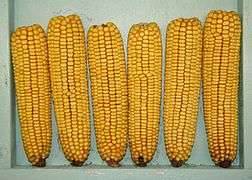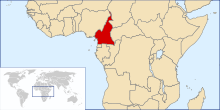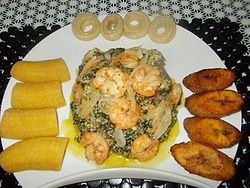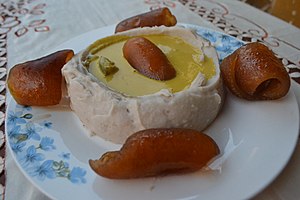Cameroonian cuisine
Cameroonian cuisine (French: cuisine camerounaise) is one of the most varied in Africa due to its location on the crossroads between the north, west, and center of the continent; the diversity in ethnicity with mixture ranging from Bantus, Semi-bantus and Shua-Arabs. Added to this is the influence of German colonialisation and later the French and English annexation of different parts of the country.
| Part of a series on the |
| Culture of Cameroon |
|---|
 |
| History |
| People |
| Languages |
| Cuisine |
| Religion |
| Art |
| Literature |
|
Music and performing arts |
|
Media |
| Sport |
|
Monuments
|
|
Symbols |
|


Overview
Staple foods in Cameroon include cassava, yams, rice, plantain, potato, sweet potatoes, maize, beans, millet, a wide variety of cocoyams, and many vegetables.
The French introduced French bread which is widely consumed and a breakfast staple in the French-speaking parts of Cameroon, while in the English speaking parts, British plain pan-loafs locally called "Kumba bread" and a less rich form of dinner rolls are very common. The main source of protein for most inhabitants is fish; poultry and beef are also eaten. Bush meat was commonly consumed, some of the most sought-after species being the pangolin, the porcupine, and the giant rat, though, because of rarity, these are looked upon now as delicacies. There is also a thriving illegal trade in endangered bush meat species such as the chimpanzee and gorilla.
Influences
Given that Cameroon was colonised repeatedly, New World staples were introduced several centuries ago, as well as European cooking techniques and culture. It is also influenced by its geography, with distinct differences between its North and South regions.[1] Cameroon is made up of over 250 ethnic groups and cuisine differs between ethnic group and also by region.[2]
Ingredients
The soil of most of the country is very fertile and a wide variety of vegetables and fruits, both domestic and imported species, are grown. These include:
Specialties

Among Cameroonian specialties are:
- Fufu corn and njama njama (garden huckle berry leaves)
- Brochettes, known locally as soya (a kind of barbecued kebab made from chicken, beef, or goat)
- Sangah (a mixture of maize, cassava leaf, and palm nut juice)
- Mbanga soup and kwacoco
- Eru and water fufu
- Ndolé (a spicy stew containing bitterleaf greens, meat, shrimp, pork rind, and peanut paste)

- Koki (food) (primarily consisting of blackeyed peas and red palm oil)
- Koki cooking varieties (Vigna unguiculata)
 Koki fritter
Koki fritter.jpg) Koki (Niébé cake)
Koki (Niébé cake) Base product
Base product
- Achu soup (cocoyam fufu with an orange/yellow red palm oil soup)

- Mbongo'o tjobi (a spicy black soup made with native herbs and spices)

- Egusi soup (ground pumpkin seeds often cooked with dark leafy greens or okra)
- Kondreh (stewed unripe plantains with herbs and spices, usually cooked with goat meat)
- Kati kati, a grilled chicken dish[3][4][5] and traditional food of the Kom.[6]
Curries, soups and fish dishes abound, as well as meats on skewers. Insects are eaten in some parts of the country (particularly the forested regions).
See also
- List of African cuisines

References
- "Cameroon". Food by Country. Retrieved 13 May 2012.
- Mbaku, John Mukum (2005). Culture and Customs of Cameroon. Westport, Conn. [u.a.]: Greenwood Press. ISBN 0-313-33231-2.
- Kouega, Jean-Paul (November 26, 2007). "A Dictionary of Cameroon English Usage". Peter Lang – via Google Books.
- Planet, Lonely; Ham, Anthony; Grosberg, Michael; Luckham, Nana; Maric, Vesna; Ranger, Helen; Sieg, Caroline; Smith, Helena; Louis, Regis St; Stiles, Paul; Butler, Stuart (September 1, 2017). "Lonely Planet West Africa". Lonely Planet – via Google Books.
- Nde, Nkwentie, Susan (March 16, 2014). "The Mirror and Nine Other Short Stories". Langaa RPCIG – via Google Books.
- Loh, Choves (January 31, 2018). "Cameroon: Laikom - the Bedrock of Kom Culture". allAfrica.com.